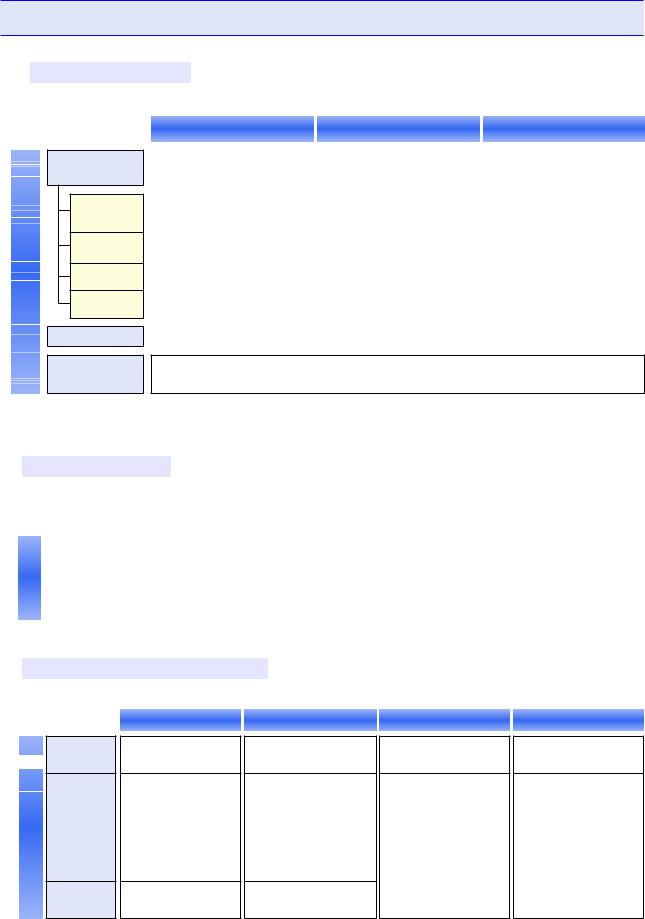
01 POWER ISLAND / 02 H2+NH3 / KOR-Hydrogen-Economy-Roadmap-of-Korea_REV-Jan19
.pdf
. National Vision for the Hydrogen Economy
Becoming the world’s leading Hydrogen economy
 Achieving the first place in FCEV and fuel cell markets
Achieving the first place in FCEV and fuel cell markets
 Evolve from a country of fossil resources to a major, eco-friendly producer of hydrogen fuel
Evolve from a country of fossil resources to a major, eco-friendly producer of hydrogen fuel
Hydrogen vehicles(FCEV)
(export) (domestic demand)
Fuel |
Power Gen. |
|
(domestic demand) |
||
Cells |
||
Homes/Buildings |
Hydrogen Supply
Hydrogen Price
|
|
|
|
|
2018 |
|
2022 |
|
2040 |
|
|
|
|
|
18,000 |
|
81,000 |
|
6,200,000 |
(900) |
|
(14,000) |
|
(3,300,000) |
(900) |
|
(67,000) |
|
(2,900,000) |
|
|
|
|
|
|
|
|
|
|
307 MW |
|
1.5 GW |
|
15 GW |
(in total) |
|
(1 GW) |
|
(8 GW) |
7 MW |
|
50 MW |
|
2.1GW |
|
|
|
|
|
130,000t/year |
|
470,000t/year |
|
5,260,000t/year↑ |
|
|
|
|
|
- |
|
KRW 6,000/kg |
|
KRW 3,000/kg |
|
Basic |
|
|
|
|
|
|
|
|
|
|
|
|
Establishing |
|
||
|
|
|
|
|
|
|
|
|
|
|
|
|
industrial |
|
|||
|
|
|
|
|
|
|
|
|
|
|
|
|
|
|
|
|
|
|
Orientation |
|
|
Ensuring safety |
|
|
|
|
|
ecosystem of |
|
||||||
|
|
for entire cycle |
|
|
|
|
|
SMBs and |
|
||||||||
|
|
|
|
|
|
|
|
|
|
|
|||||||
|
|
|
|
|
|
|
|
|
|
|
|
|
middle standing |
|
|||
|
|
|
|
|
|
|
|
|
|
|
|
|
companies |
|
|||
|
|
|
|
|
|
|
|
|
|
|
|
|
|
|
|
|
|
|
|
|
|
|
|
|
|
|
|
|
|
|
|
|
|
|
|
|
|
|
|
|
|
|
|
|
|
|
|
|
|
|
|
|
|
|
Strategies |
|
|
|
|
Preparation of |
|
|
Expansion of |
|
|
|
Leadership of |
|
|
|
|
|
|
|
|
|
hydrogen economy |
|
|
hydrogen economy |
|
|
|
hydrogen economy |
|
|
|
||
|
|
|
|
|
|
|
|
|
|
|
|
|
|
|
|
||
|
|
|
|
|
▪Hydrogen industry |
|
▪Increase in hydrogen use |
|
▪Overseas hydrogen production |
|
|
||||||
|
|
|
|
|
|
eco-system |
|
▪Large-scale supply-demand |
|
and water electrolysis |
|
|
|||||
|
|
|
|
|
|
▪Infrastructure and |
|
|
▪CO2-free supply-demand |
|
|
||||||
|
|
|
|
|
|
legal/institutional basis |
|
system |
|
|
|
|
system |
|
|
||
|
|
|
|
|
|
|
|
|
|
|
|
|
|
||||
|
|
|
|
|
|
|
|
|
|
|
|
|
|
|
|
|
|
|
|
|
|
|
|
|
|
|
|
|
|
|
|
|
|
|
|
|
Sectors Private/Public |
|
|
|
|
|
|
|
|
|
|
|
|
|
|||
|
|
|
|
|
▪Support/deregulation |
|
▪Supplementation of |
|
|
▪Establishment of |
|
|
|||||
|
|
|
|
|
|
industrial ecosystem |
|
|
|
|
|||||||
|
|
|
|
|
▪Large infrastructure |
|
|
hydrogen society |
|
|
|||||||
|
|
|
|
|
|
▪Preempting |
|
|
|
|
|
|
|||||
|
|
|
|
|
investment |
|
|
|
|
|
▪International leadership |
|
|
||||
|
|
|
|
|
|
international |
standards |
|
|
|
|||||||
|
|
|
|
|
|
|
|
|
|
|
|
|
|||||
|
|
|
PrivatePublic |
|
▪Internalization of |
|
▪Commercial |
production |
|
|
▪Expansion of private led |
|
|
||||
|
|
|
|
core technologies |
|
system |
|
|
|
|
market |
|
|
||||
|
|
|
|
▪Expansion of |
|
▪Hydrogen business |
|
▪Leadership of global |
|
|
|||||||
|
|
|
|
investment |
|
platform |
|
|
|
|
market |
|
|
||||
|
|
|
|
|
|
|
|
|
|
|
|
|
|
|
|||
|
|
|
|
|
|
|
|
|
|
|
|
|
|
|
|
|
|
- 17 -

Roadmap for the Implementation of Hydrogen Economy
□Hydrogen Mobility (cumulative)
Hydrogen vehicles(FCEV)
Passenger
Care
taxis
Buses
Trucks
Fueling Station
Trains, Ships, and
Drones
*( ): domestic demand
1,800 |
(900) |
|
81,000 |
(67,000) |
|
6,200,000 + α (2,900,000) |
|
|
|
|
|
|
|
|
|
|
|
|
|
|
|
|
|
1,800 |
(900) |
|
79,000 |
(65,000) |
|
5,900,000 |
(2,750,000) |
|
|
|
|
|
|
|
|
- |
|
|
- |
|
120,000 |
(80,000) |
|
|
|
|
|
|
|
||
2 (Total) |
|
2,000 |
(Total) |
|
60,000 (40,000) |
||
|
|
|
|
|
|
|
|
- |
|
|
- |
|
120,000 |
(30,000) |
|
|
|
|
|
|
|||
|
|
|
|
|
|||
14 |
|
310 |
|
1,200 + α |
|||
Commercialization and export projects to be implemented before 2030 through R&D and demonstrations
*Domestic demand / Proportion of Hydrogen vehicles(FCEV) among all cars (cumulative)
□Hydrogen Energy (cumulative)
|
|
|
|
|
|
|
|
*( ): domestic demand |
|
|
|
|
|
|
|
|
|
|
|
|
|
|
|
|
|
|
|
|
|
|
|
|
|
|
|
|
|
|
|
|
|
|
|
|
Fuel |
|
Generation |
|
307.6MW |
|
1.5GW (1GW) |
|
15GW + α (8GW) |
|
Households/Bui |
|
|
|
|
|
|
|
Cells |
|
|
7MW |
|
50MW |
|
2.1GW + α |
|
|
|
ldings |
|
|
|
|
|
|
|
|
|
|
|
|
|
|
|
Hydrogen Gas |
|
Technology development to be completed by 2030 |
||||||
|
|
Turbine |
|
|||||
|
|
|
|
|
|
|
|
|
□ Hydrogen Supply and Prices
Supply
 (=Demand)
(=Demand)
Supply
Methods
Hydrogen
Price
130,000 tons/year
By-product hydrogen (1%)
Hydrogen extraction (99%)
-
(Policy price)
470,000 tons/year
By-product hydrogen Hydrogen extraction Water electrolysis
KRW 6,000/kg (Initial market price)
1.94 million tons/year 5.26 million tons/year
By-product hydrogen By-product hydrogen Hydrogen Extraction Hydrogen Extraction Water electrolysis Water electrolysis Overseas production Overseas production
++: 50% |
|
++: 70% |
: 50%, |
|
: 30%, |
KRW 4,000/kg |
|
KRW 3,000/kg |
- 18 -

. Promotion Plan for the Hydrogen Economy
Leading hydrogen economy focusing on FCEV and fuel cells
 Accelerate the utilization of hydrogen, especially in the transportation and energy sectors
Accelerate the utilization of hydrogen, especially in the transportation and energy sectors
Transportation Increase price competitiveness and expand supply of Hydrogen vehicles(FCEV)
|
Expand use of hydrogen taxis and buses for public transportation |
|
|
Promote use of hydrogen trucks in the public sector |
|
|
Increase accessibility by increasing the number of hydrogen fueling stations nationwide |
|
|
Find other applications, such as hydrogen ships, trains, and drones |
|
|
Supply hydrogen fuel cells for power generation and achieve commercialization |
|
Energy |
||
to enable their export |
||
|
||
|
||
|
Expand use of hydrogen fuel cells in households and buildings |
|
|
Review and develop hydrogen gas turbines as a commercial energy |
|
|
generation source |
 Transition production paradigm from grey hydrogen to green hydrogen
Transition production paradigm from grey hydrogen to green hydrogen
Grey Hydrogen Utilize hydrogen produced as a by-product of refining and petrochemical processes Conduct large-scale hydrogen extraction based on nationwide LNG network
Green Hydrogen Reduce cost of water electrolysis and promote mass production of hydroge Introduce mass overseas CO2-free hydrogen
 Reduce cost of hydrogen distribution by establishing efficiency mass infrastructure
Reduce cost of hydrogen distribution by establishing efficiency mass infrastructure
Storage Convert from high-pressure gas storage to high-efficiency liquefaction and liquid and solid storage
Transportation Reduce cost of hydrogen distribution by establishing high-efficiency, high-capacity hydrogen storage and transportation systems
 Promote systematic safety management measures, including the enactment of the Hydrogen
Promote systematic safety management measures, including the enactment of the Hydrogen
Safety Act and establishment of the Hydrogen Safety Support Center
 Raise public awareness of the safety of hydrogen
Raise public awareness of the safety of hydrogen
Technological Innovation |
|
Professional Personnel |
|
|
Cross-ministerial technology roadmap |
Develop hydrogen safety and core technologies |
|||
Standardization |
|
Establishment of social infra |
|
|
Preempt global hydrogen standards |
Establish base for the hydrogen economy |
|||
Legal Base |
|
International Cooperation |
|
|
Enact Hydrogen Economy Act |
Implement Open Innovation |
|||
Export Industry |
|
SMBs and Middle-standing Companies |
|
|
Achieve Hydrogen vehicles(FCEV) and fuel cell |
Foster hydrogen as a hidden champion of |
|||
export industrialization |
downstream industries |
|||
- 19 -

1 Establishment of the World’s Best Hydrogen Utilization System
1. Mobility
Hydrogen vehicles(FCEV): : Establishment of Clean Transportation Infrastructure
 Hydrogen vehicles(FCEV) Supply and Major Challenges
Hydrogen vehicles(FCEV) Supply and Major Challenges 
Expansion of Hydrogen vehicles(FCEV) and Fueling Stations (cumulative)
Sectors |
||
Hydrogen vehicles(FCEV) |
|
Total |
|
|
|
|
Cars |
|
|
|
|
|
|
|
|
|
taxis |
|
|
|
|
|
Buses |
|
|
|
|
|
Trucks |
|
|
|
Fueling Stations
|
Annual production of 100,000 by 2025 |
*( ): domestic demand |
|||||
|
|
(Starting commercial production)↓ |
|||||
|
|
|
|
||||
2018 |
|
2022 |
|
2040 |
|||
1,800 |
(900) |
|
81,000 |
(67,000) |
|
6,200,000 |
(2,900,000) |
|
|
|
|
|
|
|
|
1,800 |
(900) |
|
79,000 |
(65,000) |
|
5,900,000 |
(2,750,000) |
|
|
|
|
|
|
|
|
|
|
|
|
|
|
120,000 |
(80,000) |
|
|
|
|
|
|
||
2 (Total) |
|
2,000 |
(Total) |
|
60,000 (40,000) |
||
|
|
|
|
|
|
|
|
|
|
|
|
|
|
120,000 |
(30,000) |
|
|
|
|
|
|
||
14 |
|
|
310 |
|
1,200 |
||
|
|
|
|
|
|
|
|
Major Projects
(Expansion) Expanding clean transportation infrastructure, including hydrogen passenger cars, buses, taxis, etc. (by 2022), and greatly increasing the number of hydrogen fueling stations to support such expansion.
-Building production facilities for all types of hydrogen vehicles(FCEV), including passenger cars, buses, taxis, and trucks (by 2030).
(Institutions) Providing subsidies for each type of hydrogen vehicles(FCEV) and supporting the cost of fuel for commercial hydrogen vehicles(FCEV), including buses and taxies.
-Reducing subsidies in the long term, as hydrogen and hydrogen fueling prices fall.
(Export) Sales and export of hydrogen fuel cell systems for vehicles and leading the mutual growth of SMBs.
- 20 -

1.Hydrogen Passenger Cars
Domestic Supply (cumulative): 65,000 by 2022 → 2,750,000 by 2040
Expand production capacity and localize the production of all parts
Ensuring Price Competitiveness by Expanding Production Capacity
Expand annual production to 35,000 by 2022, and 100,000 vehicles
(50,000 for domestic use + 40,000 for export) by 2025,
-(Reduce the price of Hydrogen vehicles(FCEV)) When annual production reaches 35,000 cars, the price of Hydrogen vehicles(FCEV) is expected to drop
to KRW 50 million range. When annual production reaches 100,000 cars, the price is expected to drop to a level similar to that of internal combustion cars.
-The subsidy for Hydrogen vehicles(FCEV) purchases will be phased out gradually as the price of Hydrogen vehicles(FCEV) falls. The subsidy will be eliminated when the price of Hydrogen vehicles(FCEV) becomes competitive with that of internal combustion cars.
Develop systems for the mass production of parts and secure technologies to reduce the prices of core parts of hydrogen fuel cells (stacks, hydrogen storage vessels, etc.) by 2022.
Localizing the main parts of Hydrogen vehicles(FCEV) 100%
Increase the localization rate of Hydrogen vehicles(FCEV) main parts to 100 percent by 2022 through the expansion of technology development support.
-Invest in R&D to improve technology for the production of parts and create a parts
production ecosystem (KRW 300 billion, based on the Preliminary Feasibility Study).
* Develop hydrogen fueling technology (40 to 80 percent), membrane electrode assemblies, gas diffusion layers, air compressors, hydrogen storage vessels, etc.
- 21 -

Expand basis for increasing the demand for Hydrogen vehicles(FCEV)
Introduce exclusive |
insurance to ease the burden of |
high premiums |
on consumers (by 2020). |
|
|
* Because of the low level |
of popularization of hydrogen cars, the insurance industry is |
|
in a position that makes it |
difficult to launch exclusive products for |
such vehicles. |
Improve safety by preparing measures to prevent collisions, rollovers, and fires (by 2022) and increase hydrogen storage capacity (by 2030).
2.Hydrogen Taxis
Domestic supply (cumulative) : 80,000 by 2040
After the pilot project in 2019, hydrogen taxis will be supplied extensively nationwide from 2023.
Expand nationwide after completion of pilot project (in Seoul)
Implement hydrogen taxi pilot project, in conjunction with hydrogen fueling stations in central urban areas (Seoul) → Supply hydrogen taxis in major cities by 2021 → Expand supply of hydrogen taxis nationwide by 2023
Establish plans to analyze the performance of key parts and improve
the problems discovered by operating 10 hydrogen taxis in actual road environments over 200,000km.
* 10 core parts |
that influence vehicle |
longevity, such as fuel cell stacks, |
operating |
devices (air supply, hydrogen supply, and thermal management systems), |
hydrogen |
||
storage devices, |
electrical devices, etc. |
|
|
- Provide support for expenses necessary for the demonstration of hydrogen taxis and rental of Hydrogen vehicles(FCEV).
* Car prices: Approximately KRW 25 million for |
an LPG taxi and KRW 37 million |
for a Hydrogen vehicle(FCEV) (including subsidy |
support) |
- 22 -

** Over nine years of operation, parts such as the fuel cell stack (KRW 50 million) of hydrogen taxis need to be replaced at least once or twice.
→ Taxi mileage over nine years: approximately 530,000km for private taxis and 720,000km for corporate taxis
<Foreign and Domestic Cases >
(France) 100 hydrogen taxis are currently in operation in Paris (Tuscon: 75, Mirai: 25).
→Planning to expand to 600 by 2020
(Sweden) The taxi company O2O is currently conducting a hydrogen taxi pilot project (operating Tucsons in Stockholm).
(Ulsan) Ten hydrogen taxis were in operation between 2016 and 2018 (by three companies).
Increase in longevity of Hydrogen vehicles(FCEV) 160,000km in
2018 → 300,000km by 2022 → 500,000km by 2030
Develop technologies to improve vehicle longevity based on analysis of the durability of parts of hydrogen taxis with high mileage.
3.Hydrogen Buses
Domestic supply (cumulative): 2,000 by 2022 → 40,000 by 2040
Expand the supply of hydrogen buses for express/city bus routes nationwide.
Implement pilot projects to expand the supply of hydrogen buses
(City Buses) Supply 35 hydrogen buses in seven major cities* in 2019, with the aim of replacing 2,000 city buses with hydrogen buses by 2022.
*7 in Seoul, 5 in Busan, 3 in Ulsan, 6 in Gwangju, 5 in Changwon, 4 in Asan, and 5 in Seosan
** Pilot project to supply 35 buses in 2019 →300 buses in 2020→665 buses in 2021 →1,000 buses in 2022
- (Metropolitan buses) Introduce hydrogen buses on intercity bus routes as a pilot project in 2021, based on hydrogen fueling stations on highways, and supply hydrogen buses for all intercity bus routes by 2030.
- 23 -

Replace police buses with hydrogen buses
Purchase two hydrogen buses in 2019* and operate them for
demonstration purposes until the end of 2020.
* Hyundai is developing a full-sized hydrogen bus |
that satisfies the requirements |
of |
|
police buses (passengers, |
cargo space, etc.) and expects to complete development |
in |
|
the second half of 2019 |
and deliver the bus to the |
National Police Agency. |
|
After the demonstration process is complete, police buses currently in operation that have exceeded their operational lifespan (eight years) will be promptly replaced with hydrogen buses. All police buses will eventually be replaced with hydrogen buses.
Build hydrogen bus infrastructure
Establish |
hydrogen composite transfer centers |
offering |
both fueling |
||||
and maintenance services |
at major |
traffic |
hubs |
in metropolitan |
areas |
||
by 2021 |
and introduce |
hydrogen |
buses |
on |
new bus |
routes |
and |
existing bus routes that require more buses. |
|
|
|
||||
Install hydrogen fueling stations at highway rest stops, CNG fueling stations, innovative cities, etc.
*Sign MOU on installing hydrogen fueling stations at public bus garages (first half of 2019, in cooperation with local governments and transportation associations).
Enhance economic and institutional support for hydrogen buses
Review the amount of fuel cost support based on the results of research and in consideration of the fine dust reduction effect of hydrogen buses and support the cost of bus purchases for the replacement of existing buses.
*Fueling rate structure for CNG buses: including purchase cost (central/local governments), subsidies for fueling stations (local governments), bus fuel cost subsidies, oil price subsidies, etc.
-24 -

Provide incentives, such as relaxed licensing standards for transportation companies introducing eco-friendly vehicles like hydrogen buses, and grant extra points when selecting M-bus (broad buses) business operators
* For instance, weighing up on eco-friendly buses (hydrogen buses, etc.) when calculating the number of licensed buses operated by city bus transportation businesses (bus transportation companies with 40 or more buses).
Increase the fuel economy, lifespan, and safety of hydrogen buses
(Fuel economy/lifespan) Increase fuel economy and operational lifespan of hydrogen buses by more than 50 percent and five times, respectively, compared to current levels.
*Fuel Economy: 10km/kg by 2018 → 12km/kg by 2022 → 15km/kg or higher by 2030 Lifespan: 160,000km by 2018 → 500,000km by 2022 → 800,000km or longer by 2030
(Safety) Develop technologies and prepare safety standards for hydrogen buses to prevent rollovers and collisions.
- Develop technologies for vehicles and parts to protect passengers of hydrogen buses and lead the development of technologies for Hydrogen vehicles(FCEV) to reflect international standards.
*GTR (Global Technical Regulation)
(Dedicated Parts) Design for hydrogen buses, motors, high-pressure hydrogen storage vessels, high-voltage converters, etc.
4.Hydrogen Trucks
Domestic supply(cumulative): Supply 30,000 hydrogen trucks by 2040, following the completion of development efforts
Launching medium-sized trucks (five-ton) in 2021 and heavy trucks (30-ton) in 2024.
-25 -

Convert public special freight vehicles to Hydrogen trucks
Developing |
and demonstrating the technology of 5-ton H2 trucks |
(special freight |
vehicles*) by 2020 |
*Including garbage trucks (including garbage collection), honey wagons, sprinkler trucks, etc.
Start a hydrogen truck pilot project* for the public sector in 2021
-Promote the gradual transition from domestic special freight vehicles
(approximately 14,000 units) to hydrogen trucks* (starting with five-ton trucks).
*Install (and expand) special devices such as garbage collectors, street sweepers, and street washers on five-ton hydrogen trucks.
-After the pilot project is completed, consider ways of including commercial vehicles in the public eco-car obligatory purchase targets.
Converting private freight trucks to Hydrogen trucks
Complete the development of technogies for the production of parts for
10-ton hydrogen trucks by 2020 and demonstrate such trucks by 2022.
-Carry out a logistics and transportation demonstration project for the conversion of general freight trucks* into hydrogen trucks (by 2021).
*Number of registered general freight trucks in 2018: 2,530,000 general freight cars (2,070,000 small, 310,000 medium, and 150,000 large trucks)
Secure the technology to reduce the prices* of parts exclusively for large hydrogen trucks (five or more tons) and achieve the complete localization of hydrogen truck production by 2030
*Preliminary feasibility studies are underway to improve the performance of electrical devices, motors, reducers, and fuel cell stacks
-26 -
